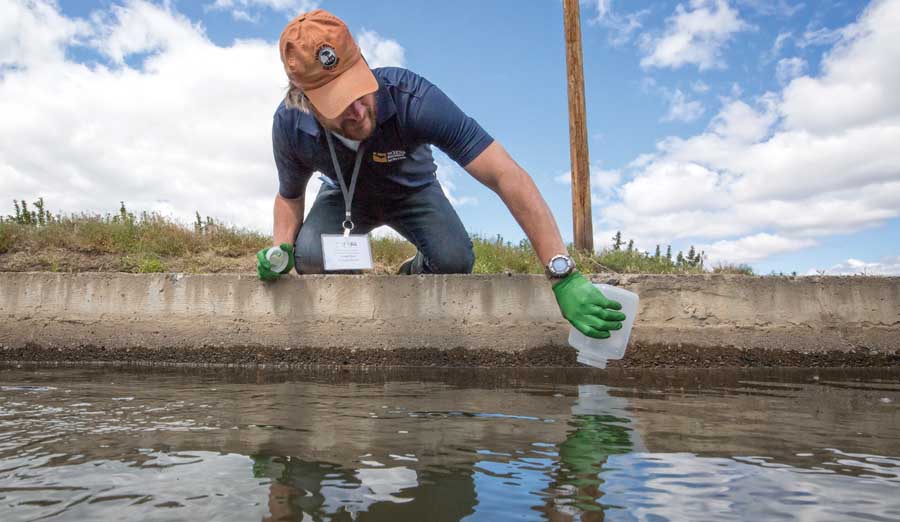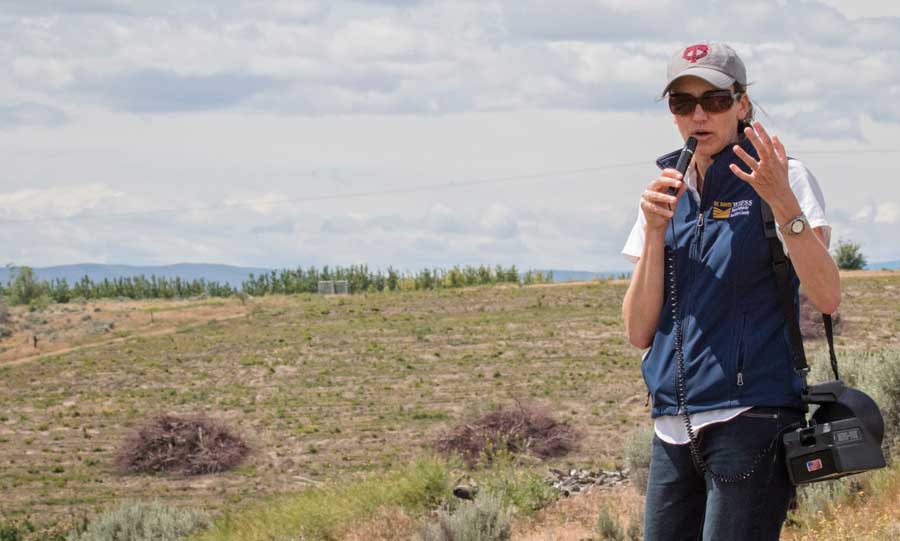
Ronald Bond of the University of California-Davis, shows a proper method for obtaining an accurate water sample during an irrigation water testing workshop in Selah, Washington, in May. Bond said samples should not be taken by skimming the surface or sides of an irrigation canal. Instead, dip the container mouth down into the water and sweep in a half-moon arc to obtain a representative sample. (TJ Mullinax/Good Fruit Grower)
As the fruit industry gears up to begin complying with new food safety regulations, many are finding them to be unclear and intimidating, with plenty of unanswered questions.
Growers and packers have been working for months to determine which of the two rules — the Produce Safety Rule and the Preventive Controls for Human Food Rule — apply to their operations under the Food Safety Modernization Act (FSMA). And researchers are working to train growers and packers about how to meet the biggest requirements of each.
For growers, that requirement is water quality sampling, and the researchers’ message is simple: Where you sample matters. When you sample matters. How you sample matters. How you test matters.
“We want to clarify some of the things in the rule that are vague, but also demystify it and empower growers with information — let them know it doesn’t have to be as scary as it seems and a lot of things they can do themselves,” said Melissa Partyka.
She is a research ecologist with the Western Center for Food Safety at the University of California-Davis, a Food and Drug Administration Center of Excellence established to conduct research, outreach and educational programs to enhance implementation of FSMA.
Most growers fall under the Produce Safety Rule, which establishes standards for the growing, harvesting, packing and holding of produce.
The rule requires growers to test their agricultural water and take certain actions should microbial tests come back above a set threshold close to harvest.
The biggest misconception about water sampling under the rule is that it’s intended to ensure food safety, Partyka said. It’s not.
FSMA compliance for this agricultural rule is meant to ensure growers determine and understand the variability of their water quality, which requires monitoring.
Things are messy in the outdoors, Partyka said, and there’s plenty of variability to be found in an orchard or vineyard and near your water source.
If it’s raining hard in the mountains or upstream, there could be high runoff and higher turbidity in surface water. At certain times of year, animals are more active, resulting in greater potential for contaminants.
A neighbor could be pulling out an orchard, driving wildlife closer to your property or water source or creating runoff.
The water quality requirements under the rule require growers to monitor irrigation water for the presence of generic Escherichia coli (E. coli), which indicates the presence of fecal contamination, if it could come into contact with the harvestable portion of a crop. It doesn’t matter if that water is being applied through sprinkler irrigation, overhead cooling or other means.
Growers who use drip or micro jet irrigation may think they are exempt, Partyka said, but if they use irrigation water in their pesticide sprayers, then the water could come into contact with the crop and monitoring is required.

During the workshop, Melissa Partyka of the University of California-Davis pointed out several environmental factors that can impact water quality, such as runoff, changes in canal banks, nearby animals and, as seen in the background, alterations to neighboring orchards and land. (TJ Mullinax/Good Fruit Grower)
For tips on how to properly take a water sample, read “Water sampling 101”.
Understanding the rule
The Produce Safety Rule requires untreated surface water that could come into contact with produce to undergo a minimum of 20 samples, collected as close as feasible to harvest, over the course of two to four years.
The initial findings are used to calculate a geometric mean (GM) and statistical threshold (STV), which together create the microbial water quality profile for that source.
A single positive sample can’t be seen as a “hit” — a word researchers would like to remove from the lexicon, said Ronald Bond, water quality researcher at WCFS.
In TMDL (total maximum daily load) water sampling for environmental purposes, a “hit” requires continued testing until the problem is cleared up, he said. In this case, growers will take 20 samples over the sampling period.
Each year thereafter, five more samples will be added and the oldest five will be dropped, creating a rolling geometric mean.
For untreated ground water that is directly applied to growing produce, growers are required to do an initial survey using a minimum of four samples, with a minimum of one new sample each year thereafter.
One sample with high levels doesn’t necessarily mean a grower has a water quality problem, Partyka said. The series of samples are needed to understand the variability of the water quality, and not everyone’s variability is going to be the same.
“Variability at the start of the season is likely to be different by the end of the season, and you need to understand what makes your system unique,” she said.
Understanding the math
Partyka and Bond, joined by researcher Jennifer Chase of WCFS, conducted a training seminar for irrigation district personnel and packing house food safety compliance officers at several sites in Washington in May.
The hope is that those who have been trained will help to initially spread the word and offer guidance to growers. More training seminars are planned for growers in the coming months.
However, a key point the researchers made during the training was that a late rule change by the U.S. Food and Drug Administration could affect the method or laboratory a grower might choose to analyze samples.
Most probable number (MPN) and colony-forming units (CFU) are both estimates of fecal indicator bacteria concentration and are common measures of water quality in aquatic environments. CFU is a count of bacterial colonies grown on a petri dish, while MPN is based on a statistical estimation.
MPN methods for indicators have yet to be adequately vetted scientifically for epidemiological use, or for human contact, Bond said, and the FDA has ruled it is not acceptable for use under FSMA.
That means growers must ensure that they use — or that the laboratory they hire to analyze their sample — uses a CFU analysis instead of an MPN analysis.
Specifically, the FDA has stated that EPA Method 1603 is the only currently acceptable method for analyzing your samples. Any other method requires scientific verification.
Under the Produce Safety Rule, the geometric mean of a grower’s samples must be 126 CFU or less of generic E. coli per 100 milliliters of water (2.1 log10 E. coli). The statistical threshold of samples is 410 CFU or less of generic E. coli in 100 milliliters of water (2.6 log10 E. coli).
Several tools have been developed to make it easier to calculate the geometric mean and statistical threshold to determine if water meets standards for unrestricted application before harvest.
UC-Davis (WCFS) has created Excel tools both for those using untreated surface water or untreated ground water. (See link below)
In addition, the University of Arizona Cooperative Extension has developed an online calculator and ag water app to aid growers.
Visit the Western Center for Food Safety online for links to those sites at wcfs.ucdavis.edu. •
– by Shannon Dininny
FSMA: The two rules
Growers are covered by the Produce Safety Rule, which lays out standards for the growing, harvesting, packing and holding of produce. Some fresh fruit packers might fall under the Produce Safety Rule if most of the fruit they pack comes from company-owned orchards, though the location of the orchards is also a factor.
However, if most of the fruit comes from outside growers, the packer will likely fall under the Preventive Controls for Human Food Rule instead.
Packers who handle fruit from their own orchards and from other growers will need to determine which rule applies to them. This also applies to storage facilities.
Very small growers — those with less than $250,000 in annual produce sales — will have four years from Jan. 26, 2016 to comply with most provisions in the rule.
Growers with $250,000 to $500,000 in sales will have three years to comply, and all others will have two years.
However, growers will be given an additional two years to meet the water quality standards because of concerns about the difficulty that growers may have in meeting these new requirements.






Leave A Comment